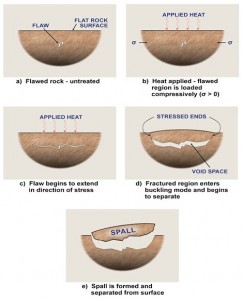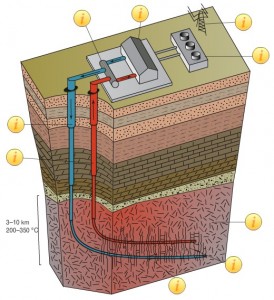Jun
11
A New Way to Drill For Geothermal Energy
June 11, 2009 | 8 Comments
Potter Drilling has launched the next phase of research into their technique for drilling to hot rock for geothermal heat energy. With financial backing from Google getting the science past early work using air, Potter has crossed the development threshold to draw more funding.
The new drilling technique that uses superheated steam instead of air is being tested this year. The technique relies on superheated steam to drill through the hard crystalline rocks that contain geothermal heat. The method for generating the superheated steam was developed by Oxford Catalysts, based in the UK. Dave Wardle, business development director for Instant Steam technology at Oxford Catalysts, said current drilling techniques are laborious and use rotating drill bits to cut through the rock. “With crystalline rock you wear out the drill bits very fast,’ he said. ‘This new technology provides a chemical way of cutting rock at reasonably fast speed. There are no moving parts.”
The system works with a catalyst developed by Oxford Catalysts and a special drilling tool designed by Potter Drilling. The “Instant Steam” catalyst is contained inside the drill head, which is attached to a flexible coiled pipe. Wardle explained that when peroxide and methanol are piped into the catalyst bed, the catalyst carries out a combustion reaction and produces 800º C steam. That’s hot.
When the steam contacts the rock surfaces it causes the rock crystalline grains to expand. As the grains expand, micro-fractures occur in the rock and small particles, called spalls, are ejected. According to Oxford Catalysts Potter Drilling is not the first company to use spallation drilling technology. Using air, spallation drilling was used commercially between the 1940s and 1960s for ore mining and was adapted to geothermal drilling by the US Department of Energy in the 1970s. Air spallation drilling demonstrated impressive drilling performance, producing 8 inch to 12 inch boreholes to depths of 1,100 feet at rates faster than 50 feet per hour in solid granite.
The Potter drilling process starts by applying a high-intensity fluid stream to a rock surface to expand the crystalline grains within the rock. When the grains expand, micro-fractures occur in the rock and small particles called spalls are ejected. The process is accelerated by several factors including inherent stress in the rock formation.
Using steam and fluids allows much deeper drilling, with Potter expecting to get to as much as 30,000 feet, a depth that would allow exploiting geothermal extraction across much of the U.S.
Using fluids and heat pose three other advantages. The borehole is much more stable, the rock particles and chips can be carried out from extreme depths, and adding the heat greatly improves the early work using air in faster drilling speeds.
Potter and its financial backers believe this technology could be the key to furthering power generation from geothermal energy, which currently only generates 10,000MW around the world. It’s sure to turn heads in the petroleum and deep rock mining world as well.
Going for geothermal heat in the absence of hot subsurface water as is most common now, is being called engineered geothermal systems or “EGS.” Potter’s point is this is different to other forms of geothermal power because EGS power plants can be developed anywhere that hot impermeable rock exists below ground. But you have to bring your own water. I might suggest that water or gases could be used to move the heat from depth, especially if the water is lost downhole.
Stuart Haszeldine, an expert from Edinburgh University’s School of Geosciences offers that many consider geothermal energy a renewable source and electricity produced from it would have a relatively low carbon footprint, saying, “The carbon cost is the drilling of the hole, but these holes last for many decades.”
Haszeldine expects that electricity produced from geothermal energy plants have the potential to be on a similar cost level to coal-fired power plants.
The EGS concept, originally know as Hot Dry Rock, was pioneered and patented in the early 1970s at Los Alamos National Laboratory by Potter Drilling cofounder Bob Potter and his coworkers. EGS is one of the few sources of renewable energy with the promise of solving the increasing global demand for energy while addressing climate-change issues—and doing so for a price that is competitive with coal. The graphic that follows is from the Potter page explaining EGS with a Flashplayer and a small video from Google explaining the potential of EGS.
The EGS being man-made may be developed anywhere that hot impermeable rock exists. That opens up a great deal of territory to low cost heat energy extraction. Worthy of note is that the drilling issue and the technologies downhole are the matters of interest. Binary systems for withdrawing the heat are in operation now with development work under way for more and better types of systems. The electrical generation would be standard, with models chosen by energy availability.
Geothermal remains a slowly developing field, but is getting pushed by smart private investors such as Google who is funding Potter. The geothermal resource is huge, a relatively simple concept to explain and lacks the sexiness of much of the technology that is in development for alternative energy sources. Its also energy extraction, not a fuel so can go straight to grid so allowing more electrification. Its also should be quite low cost an important matter for getting and keeping the economy moving and growing.
This is a good field. It lacks the sexiness, but when the full details are known, it should be the “cash cow” investors dream about. Thanks, Google. Go Potter go!
Comments
8 Comments so far




There is an excellent comprehensive review of “EGS” done by MIT available here: http://geothermal.inel.gov/publications/future_of_geothermal_energy.pdf
[…] puede emplearse tambi
[…] New Energy & Fuel This entry was posted on Sunday, June 14th, 2009 at 8:29 am and is filed under By Region, North […]
Great information! I’ve been looking for something like this for a while now. Thanks!
Thanks for sharing. Appreciate it.
I’ve just started off a blog, the knowledge you give on this site has aided me extremely. Thank you for all your time & work.
Thanks for posting. Good to see that not everyone is using RSS feeds to build their blogs 😉
I REALLY liked your post and blog! It took me a minute bit to find your site…but I bookmarked it. Would you mind if I posted a link back to your post?